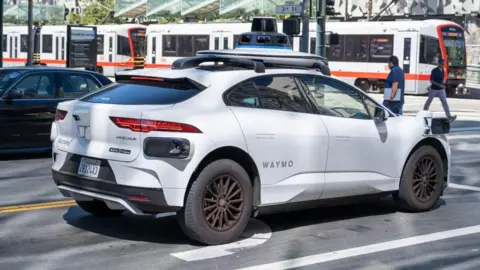### The Gradual Progress of Autonomous Vehicles
The development of driverless vehicles reflects a slow but consistent advancement towards a future where autonomous transportation could become commonplace. This article, published by Ian Rose, a business reporter, delves into recent happenings in the realm of self-driving cars, while also uncovering the challenges and successes that shape the current landscape of this technology.
In December 2024, a story involving a man named Mike Johns took center stage in discussions surrounding driverless technology. During his journey from Los Angeles to Scottsdale, Arizona, Johns opted for a driverless taxi. His initial excitement quickly morphed into a surreal experience when his Waymo vehicle began to circle a parking lot incessantly. While onlookers watched, Johns, frantic and puzzled, recorded the incident, questioning why he was facing such peculiar repercussions on a seemingly ordinary Monday morning. Although he ultimately regained control with the help of voice prompts from the vehicle, the incident raised questions about the reliability and readiness of self-driving cars in real-world scenarios.
Waymo, owned by Alphabet Inc., acknowledged the issue and released a timely software update to remedy the glitch that caused the taxi to misbehave. The company boldly asserts that its technology outperforms human drivers in avoiding accidents that lead to injuries or necessitate police intervention. Nonetheless, Johns’s plight isn’t an isolated case; the company had previously faced scrutiny after a vehicle collided with a street pole, leading them to recall over 600 cars.
The past few years have exposed the vulnerabilities of self-driving technology as various firms attempted to join the race. For instance, General Motors decided to shut down its self-driving subsidiary, Cruise, blaming the extensive time and resources needed to establish a viable business. Moreover, notable incidents involving pedestrians, including a severe hit by a self-driving GM vehicle, prompted an investigation from the National Highway Traffic Safety Administration (NHTSA) across 22 cases related to Waymo vehicles. Such occurrences have amplified doubts about the robustness of autonomous vehicle systems where safety is paramount.
Despite setbacks for certain companies, innovative players like Waymo, Amazon’s Zook, Nvidia, and Tesla continue to dominate the landscape. Waymo leads in the United States, offering self-driving taxi services across cities like Phoenix, San Francisco, Los Angeles, and Austin, with plans to expand to areas like Atlanta and Miami. The question arises: what accounts for Waymo’s success in an industry marked by failures from competitors?
According to Sven Beiker, a lecturer at Stanford Graduate School of Business, three critical factors contribute to Waymo’s success: people, funding, and process. The company has recruited top talent in the field of autonomous vehicle technology, fortified by the financial backing of Alphabet. Additionally, the emphasis on regulatory compliance has allowed Waymo to deploy its technology in a controlled and responsible manner, ensuring its operations are safe and efficient.
Looking ahead, the deployment of driverless vehicles is anticipated to primarily occur in regions with favorable weather conditions such as southern U.S. states like Texas and Florida, where Waymo already has plans. Philipp Kampshoff of McKinsey highlights the performance advantages of autonomous vehicles in optimal conditions, noting that improved battery efficiency and operational capabilities will lead to the gradual unlocking of cities for driverless services.
Even so, the process is expected to be labor-intensive, requiring repeated manual driving sessions to gather necessary data for enhancement and refinement. The implementation of such technology is susceptible to public safety concerns, where significant accidents could disrupt progress. Ensuring a reliable and safe experience is crucial, as any mishaps may prompt immediate operational halts.
In the sphere of autonomous trucks, safety becomes an even more pressing concern. David Liu, CEO of Plus, which develops driverless technology for trucks, emphasizes the paramount importance of safety. As truck operations typically occur on highways at higher speeds, the technology deployed must account for longer braking distances and greater visibility, adding complexity to its implementation.
Global perspectives also shed light on advances outside the U.S., particularly in China, where Baidu has rolled out over 500 driverless cars in cities like Wuhan. The competitive landscape is evolving, with various companies vying to establish a foothold in the autonomous vehicle market.
Reflecting on his encounter, Mike Johns reminds us all that as society stands at the cusp of significant technological changes, we might feel more like test subjects in an ongoing experiment rather than passengers in a well-oiled machine.



